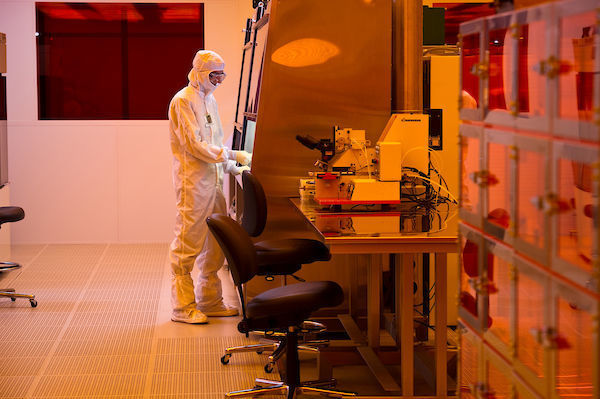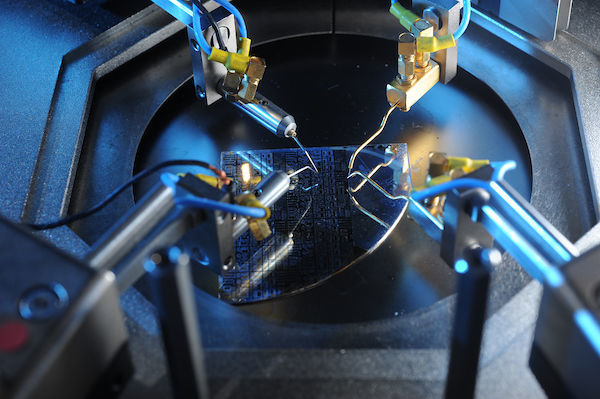Professor Porod in the lab with a graduate student
http://science.nd.edu/news/the-rise-of-nanotechnology-research-at-notre-dame/
http://science.nd.edu/news/the-rise-of-nanotechnology-research-at-notre-dame/
Author: Brandi Klingerman
Notre Dame’s nanotechnology research efforts date back to the 1980s, when the studies were mostly simulation-based and focused on computation advancements. In the three decades since, research at the University’s Center for Nano Science and Technology (NDnano) has grown and evolved in a forward-thinking and distinctive way.
To differentiate and accelerate their work, Wolfgang Porod, the Frank M. Freimann Professor of Electrical Engineeringand Director of NDnano, and his colleagues turned to Moore’s Law – an observation that states the number of components per integrated circuit, or a microchip, doubles approximately every two years – as their strategy for standing apart in a competitive and fast-paced discipline. In explaining this, Porod said, “My colleague, Gary Bernstein, the Frank M. Freimann Professor of Electrical Engineering, wanted to carve out our own area of expertise and we knew that wherever the current technological capabilities were, the more crowded the field would be. So instead, we looked beyond the popular topics and focused not just on device physics, but also on how our advancements could be applied to a variety of technologies.”
 A Notre Dame researcher working in the NDNF
A Notre Dame researcher working in the NDNF
This strategy allowed Notre Dame researchers like Porod, Bernstein, and Craig Lent, the Frank M. Freimann Chair Professor of Electrical Engineering, and others to leverage developments to not only attract new faculty, but also to fund research centers, including the Midwest Institute for Nanoelectronics Discovery (MIND) and the Center for Low Energy Systems Technology (LEAST), which were both directed by Alan Seabaugh, the Frank M. Freimann Chair Professor of Electrical Engineering. This growth of nanotechnology also supported the eventual construction of the Notre Dame Nanofabrication Facility (NDNF), a 9,000 square foot cleanroom that opened in 2010 and allows researchers to use a wide range of materials and a variety of processes and techniques.
“Not only has our state-of-the-art cleanroom advanced the kind of research we can do on campus, but it is also a great benefit to all levels of students,” said Porod. “Currently, undergraduate engineering students have the option to take a fabrication course with Greg Snider, professor of electrical engineering, in the NDNF. In the class, the students begin with blank silicon wafers and ultimately create integrated circuits that contain thousands of individual devices. This course focuses on repeatability and yield, which is essential for real-world applications when these students enter the workforce.”
 A silicon wafer being developed at the NDNF
A silicon wafer being developed at the NDNF
One of Porod’s current projects, which is supported by a gift from the Joseph F. Trustey Endowments for Excellence, is a collaboration with Bernstein that focuses on electromagnetic radiation to detect infrared (IR) and terahertz (THz) frequencies. The THz frequency range is much faster than gigahertz, which is what cell phones and radar currently operate on. THz, therefore, has the potential to improve broadband communication systems, but there are few electronic devices that operate on it. For this research, the Notre Dame researchers are developing nanoscale antennas; as the THz currents heat up the antennas, thermo-electronic detection is used to identify the current at that frequency.
“Since the term nanotechnology really refers to a scale of size rather than a specific type of technology, it brings together not only experimentalists and theorists like Bernstein and me, but also all kinds of research across campus,” said Porod. “At NDnano, our researchers are working on everything from developing new materials, to energy harvesting technologies, to cancer diagnostics – ultimately working to use their research as a powerful means for doing good in the world.”
NDnano is a world-class, collaborative research center that includes faculty from departments across the Colleges of Engineering and Science. The Center is focused on developing, characterizing, and applying new nanotechnology-based materials, processes, devices, and solutions that will better society. To learn more about NDnano, please visit nano.nd.edu.
Originally published by at research.nd.edu on August 23, 2017.

No comments:
Post a Comment